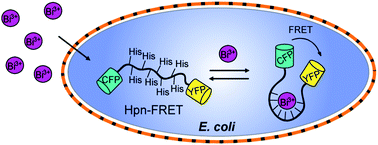Scientists have converted a protein from a pathogenic bacterium into a FRET-based fluorescent probe to help find out why bismuth therapeutics can treat gastric illnesses.
Helicobacter pylori is a bacterium that colonises the digestive track and causes chronic gastritis, ulcers and even some gastric cancers. Bismuth-containing medicines are known treatments for H. pylori. It is thought that bismuth ions bind to metal binding sites in H. pylori’s metalloproteins but their exact mechanism of action is unknown.
Chuan He and colleagues at the University of Chicago investigated the metal binding properties of their FRET probe, made from the Hpn protein found in H. pylori, with different biometals in vitro. They showed that the sensor has a high affinity for Ni2+ and Zn2+ and moderate affinity for Bi3+. They then used the sensor in E. coli cells, which act as a model system for H. pylori, to measure uptake of these three ions. To their surprise, E. coli concentrated significant amounts of Bi3+, but not Ni2+ or Zn2+.
If Bi3+ accumulates to similarly high levels in H. pylori, says He, it may target Hpn, eventually killing the bacteria.
Read the Edge article online today and let us know what you think of this work by leaving your comments below.











